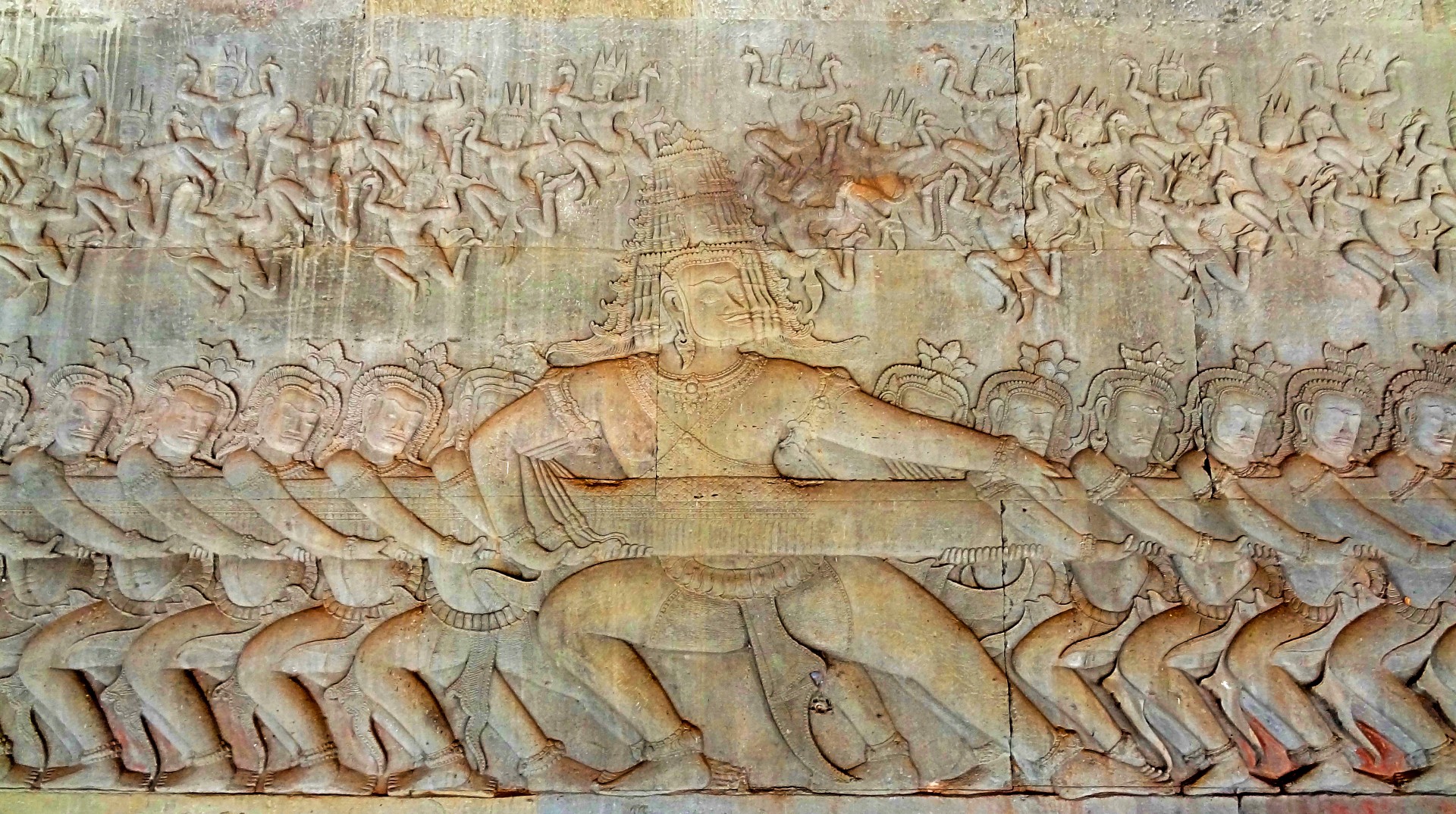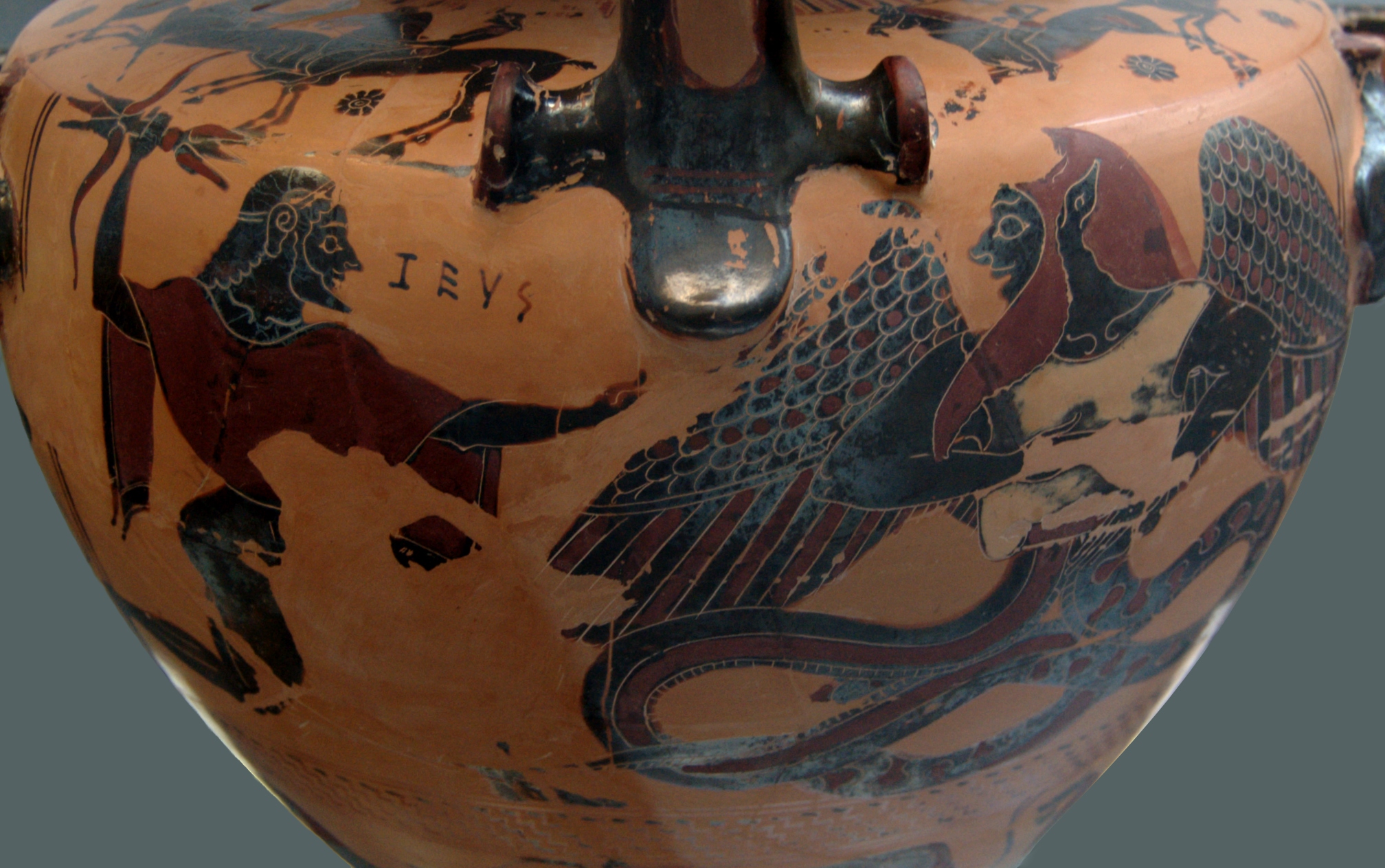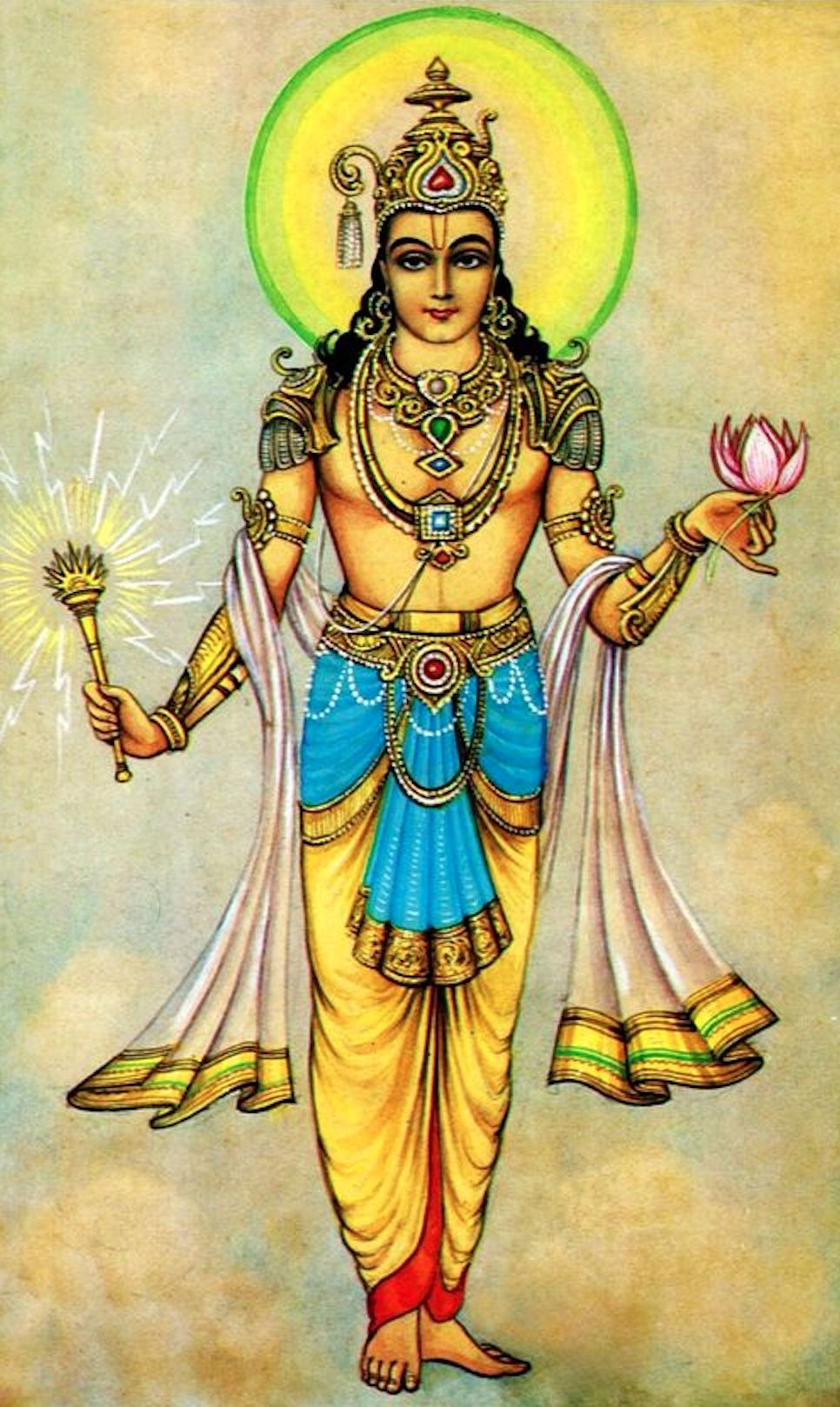|
Vrtra
Vritra (, , ) is a danava in Hinduism. He serves as the personification of drought, and is an adversary of the king of the devas, Indra. As a danava, he belongs to the race of the asuras. Vritra is also known in the Vedas as Ahi ( ). He appears as a human-like serpent blocking the course of the Rigvedic rivers, and is slain by Indra with his newly forged vajra. Etymology ''Vritra'' literally means "cover, obstacle", in reference of him holding back the waters. It stems from Proto-Indo-Iranian ''*wr̥trás'', from the Proto-Indo-European root ''*wer-'' "to cover, to obstruct". The Indo-Iranian word is also found in Avestan as '' vərəθraγna'' (Vedic ''vṛtraghná''), literally "(one who) slays obstacles". Functionally, he is related to Jörmungandr of Norse myth, Typhon of Greek myth, and Veles of Slavic myth. Literature Vedas According to the Rig Veda, Vritra kept the waters of the world captive until he was killed by Indra, who destroyed all the 99 fortresses o ... [...More Info...] [...Related Items...] OR: [Wikipedia] [Google] [Baidu] |
Verethragna
Verethragna or Bahram () is a Zoroastrian yazata. The neuter noun ''verethragna'' is related to Avestan ''verethra'', 'obstacle' and ''verethragnan'', 'victorious'. Representing this concept is the divinity Verethragna, who is the Hypostasis (linguistics), hypostasis of "victory", and "as a giver of victory Verethragna plainly enjoyed the greatest popularity of old." In Zoroastrian Middle Persian, Verethragna became , from which Vahram, Vehram, Bahram, Behram and other variants derive. The Proto-Aryan adjective *vrtraghan, which corresponds to the Avestan noun Verethragna, also has an etymological cognate in Vedic Sanskrit - Vrtra. In Vedic literature, Vrtrahan is predominantly an epithet used for Indra after he defeated Vrtra. Vrtrahan literally means "slayer of Vrtra." The name and, to some extent, the deity was borrowed into Armenian mythology, Armenian and , and has cognates in Sogdian language, Buddhist Sogdian , Parthian language, Manichaean Parthian , Bactrian la ... [...More Info...] [...Related Items...] OR: [Wikipedia] [Google] [Baidu] |
Asura
Asuras () are a class of beings in Indian religions, and later Persian and Turkic mythology. They are described as power-seeking beings related to the more benevolent Devas (also known as Suras) in Hinduism. In its Buddhist context, the word is translated as "titan" or " antigod". According to Hindu texts, the asuras are in constant fear of the devas. Asuras are described in Indian texts as powerful superhuman demigods with good or bad qualities. In early Vedic literature, the good Asuras are called '' Adityas'' and are led by Varuna, while the malevolent ones are called '' Danavas'' and are led by Vritra. In the earliest layer of Vedic texts, Agni, Indra and other gods are also called Asuras, in the sense of their being "lords" of their respective domains, knowledge and abilities. In later Vedic and post-Vedic texts, the benevolent gods are called ''Devas'', while malevolent Asuras compete against these Devas and are considered "enem ... [...More Info...] [...Related Items...] OR: [Wikipedia] [Google] [Baidu] |
Asuras
Asuras () are a class of beings in Indian religions, and later Persian and Turkic mythology. They are described as power-seeking beings related to the more benevolent Deva (Hinduism), Devas (also known as Suras) in Hinduism. In its Buddhism, Buddhist context, the word is translated as "Titan (mythology), titan" or "wiktionary:antigod, antigod". According to Hindu texts, the asuras are in constant fear of the devas. Asuras are described in Indian texts as powerful superhuman Demigod#Hinduism, demigods with good or bad qualities. In early Vedic literature, the good Asuras are called ''Adityas'' and are led by Varuna, while the malevolent ones are called ''Danava (Hinduism), Danavas'' and are led by Vritra. In the earliest layer of Vedic texts, Agni, Indra and other gods are also called Asuras, in the sense of their being "lords" of their respective domains, knowledge and abilities. In later Vedic and post-Vedic texts, the benevolent gods are ... [...More Info...] [...Related Items...] OR: [Wikipedia] [Google] [Baidu] |
Asura
Asuras () are a class of beings in Indian religions, and later Persian and Turkic mythology. They are described as power-seeking beings related to the more benevolent Devas (also known as Suras) in Hinduism. In its Buddhist context, the word is translated as "titan" or " antigod". According to Hindu texts, the asuras are in constant fear of the devas. Asuras are described in Indian texts as powerful superhuman demigods with good or bad qualities. In early Vedic literature, the good Asuras are called '' Adityas'' and are led by Varuna, while the malevolent ones are called '' Danavas'' and are led by Vritra. In the earliest layer of Vedic texts, Agni, Indra and other gods are also called Asuras, in the sense of their being "lords" of their respective domains, knowledge and abilities. In later Vedic and post-Vedic texts, the benevolent gods are called ''Devas'', while malevolent Asuras compete against these Devas and are considered "enem ... [...More Info...] [...Related Items...] OR: [Wikipedia] [Google] [Baidu] |
Vamana
Vamana (, ) also known as Trivikrama (), Urukrama (), Upendra (), Dadhivamana (, ), and Balibandhana (), is an Dashavatara, avatar of the Hinduism, Hindu deity Vishnu. He is the fifth avatar of Vishnu and the first Dashavatara in the Treta Yuga, after Narasimha. First mentioned in the Vedas, Vamana is most commonly associated in the Hindu epics and Puranas with the story of taking back the three worlds (collectively referred to as the Trailokya) from the daitya-king Mahabali by taking three steps to restore the cosmic order and push Mahabali into the netherworld. He is the youngest among the adityas, the sons of Aditi and the sage Kashyapa. Nomenclature and etymology 'Vāmana' (Sanskrit वामन) means 'dwarf', 'small' or 'small or short in stature'. It also means 'dwarfish bull', which is notable as Vishnu is directly associated with dwarfish animals (including bulls) in the Vedas (see below). Stated in Puranic literature to be born of the great sage Kashyapa and his ... [...More Info...] [...Related Items...] OR: [Wikipedia] [Google] [Baidu] |
Rig Veda
The ''Rigveda'' or ''Rig Veda'' (, , from wikt:ऋच्, ऋच्, "praise" and wikt:वेद, वेद, "knowledge") is an ancient Indian Miscellany, collection of Vedic Sanskrit hymns (''sūktas''). It is one of the four sacred canonical Hindu texts (''śruti'') known as the Vedas. Only one Shakha of the many survive today, namely the Shakala Shakha, Śakalya Shakha. Much of the contents contained in the remaining Shakhas are now lost or are not available in the public forum. The ''Rigveda'' is the oldest known Vedic Sanskrit text. Its early layers are among the oldest extant texts in any Indo-European language. Most scholars believe that the sounds and texts of the ''Rigveda'' have been orally transmitted with precision since the 2nd millennium BCE, through Indian mathematics#Styles of memorisation, methods of memorisation of exceptional complexity, rigour and fidelity, though the dates are not confirmed and remain contentious till concrete evidence surfaces. Philolog ... [...More Info...] [...Related Items...] OR: [Wikipedia] [Google] [Baidu] |
Typhon
Typhon (; , ), also Typhoeus (; ), Typhaon () or Typhos (), was a monstrous serpentine giant and one of the deadliest creatures in Greek mythology. According to Hesiod, Typhon was the son of Gaia and Tartarus. However, one source has Typhon as the son of Hera alone, while another makes Typhon the offspring of Cronus. Typhon and his mate Echidna were the progenitors of many famous monsters. Typhon attempted to overthrow Zeus for the supremacy of the cosmos. The two fought a cataclysmic battle, which Zeus finally won with the aid of his thunderbolts. Defeated, Typhon was cast into Tartarus, or buried underneath Mount Etna, or in later accounts, the island of Ischia. Typhon mythology is part of the Greek succession myth, which explained how Zeus came to rule the gods. Typhon's story is also connected with that of Python (the serpent killed by Apollo), and both stories probably derived from several Near Eastern antecedents. Typhon was (from ) also identified with the Egyptian god o ... [...More Info...] [...Related Items...] OR: [Wikipedia] [Google] [Baidu] |
Varuna
Varuna (; , ) is a Hindu god. He is one of the earliest deities in pantheon, whose role underwent a significant transformation from the Vedic to the Puranic periods. In the early Vedic era, Varuna is seen as the god-sovereign, ruling the sky and embodying divine authority. He is also mentioned as the king of asuras, who gained the status of a deva, serving as the chief of the Adityas, a group of celestial deities. He maintains truth and ''ṛta'', the cosmic and moral order, and was invoked as an omniscient ethical judge, with the stars symbolizing his watchful eyes or spies. Frequently paired with Mitra, Varuna represents the magical and speculative aspects of sovereignty, overseeing the relationship between gods and humans. The transition from the Vedic to later periods saw Varuna's domain begin to shift from the firmament to waters. He became associated with celestial waters, marking the initial phase of his transformation. By the time of the '' Itihasa-Purana'', Varuna ha ... [...More Info...] [...Related Items...] OR: [Wikipedia] [Google] [Baidu] |
Danu (Asura)
Danu (, ) is a Hindu primordial goddess. She is mentioned in the ''Rigveda'' to be the mother of the eponymous race known as the danavas. The word ''Danu'' described the primeval waters that this deity perhaps embodied. In later Hinduism, she is described as the daughter of the Prajapati Daksha and his spouse Panchajani, and the consort of the sage Kashyapa. Etymology As a word for "rain" or "liquid", ''dānu'' is compared to Avestan ''dānu'', "river", and further to river names like Don, Danube, Dnieper, Dniestr, etc. There is also a Danu river in Nepal. The "liquid" word is mostly neutral, but appears as feminine in RV 1.54. Literature Rigveda In the ''Rigveda'' (I.32.9), she is identified as the mother of Vritra, the asura slain by Indra. Padma Purana In the Padma Purana, the children of Danu are described: Brahmanda Purana In the Brahmanda Purana, it is stated that while Aditi is habitually righteous, and Diti was habitually strong, Danu habitually prac ... [...More Info...] [...Related Items...] OR: [Wikipedia] [Google] [Baidu] |
Vajrayudha
The Vajra (, , ), is a legendary and ritualistic tool, symbolizing the properties of a diamond (indestructibility) and a thunderbolt (irresistible force). It is also described as a "ritual weapon". The use of the bell and vajra together as symbolic and ritual tools is found in all schools of Tibetan Buddhism. The vajra is a round, symmetrical metal scepter with two ribbed spherical heads. The ribs may meet in a ball-shaped top, or they may be separate and end in sharp points. The vajra is considered inseparable from the bell, and both are sold in dharma stores only in matching sets. The bell is also metal with a ribbed spherical head. The bell also depicts the face of Dhatvisvari, a female buddha and the consort of Akshobhya. The vajra has also been associated as the weapon of Indra, the Vedic king of the Deva (Hinduism), devas and Svarga, heaven. It is used symbolically by the dharma, dharmic traditions of Hinduism, Buddhism, and Jainism, often to represent firmness of spir ... [...More Info...] [...Related Items...] OR: [Wikipedia] [Google] [Baidu] |
Tvashtri
Tvashtr (, ) or Tvashta (, ) is a Vedic Hindu artisan god or fashioner. He is mentioned as an Aditya (sons of goddess Aditi) in later Hindu scriptures like the ''Mahabharata'' and ''Puranas'', though his significance gets reduced. Tvashtr is sometimes identified with another artisan deity named Vishvakarma. In Hindu Literature In the ''Rigveda'', Tvashtr is stated to be a skillful craftsman who created many implements, including Indra's bolt, the axe of Brihaspati, and a cup for divine food and drink. He is stated to be the creator of forms, and is often stated to be the crafter of living beings and wombs. He is also considered a universal father, and an ancestor of humans through his daughter Saranyu. He is the father of Bṛhaspati, and likely Indra's father as well. He wields a metal axe, and rides a chariot pulled by two fallow bay mares. He is the guardian of Soma, and his son Vishvarupa is the guardian of cows. Indra has a conflict with his likely father Tvashtr, wit ... [...More Info...] [...Related Items...] OR: [Wikipedia] [Google] [Baidu] |
Soma (drink)
In the Vedic tradition, ''soma'' () is a ritual drink of importance among the early Vedic Indo-Aryans. The Rigveda mentions it, particularly in the Soma Mandala. Gita mentions the drink in chapter 9. It is equivalent to the Iranian haoma. The texts describe the preparation of soma by means of extracting the juice from a plant, the identity of which is now unknown and debated among scholars. Both in the ancient religions of Historical Vedic religion and Zoroastrianism, the name of the drink and the plant are not exactly the same.Victor Sarianidi, Viktor Sarianidi in The PBS Documentary The Story of India There has been much speculation about the most likely identity of the original plant. Traditional Indian accounts, such as those from practitioners of Ayurveda, Siddha medicine, and Somayajna called Somayajis, identify the plant as "Somalata" ('' Cynanchum acidum''). Non-Indian researchers have proposed candidates including ''Amanita muscaria'', ''Psilocybin'' mushroo ... [...More Info...] [...Related Items...] OR: [Wikipedia] [Google] [Baidu] |





